"Outside of a dog, a book is a man's best friend. Inside of a dog, it's too dark to read." -Groucho Marx
"While no one has proved that wormholes exist, that does not for a moment keep the more adventurous of thinkers from trying to figure how they might behave."
-Michael Lemonick, Time magazine
Wormholes. We've all heard the word before, and we're used to the concept (thanks to science fiction) that wormholes could be tunnels to either completely different locations in space or in time!
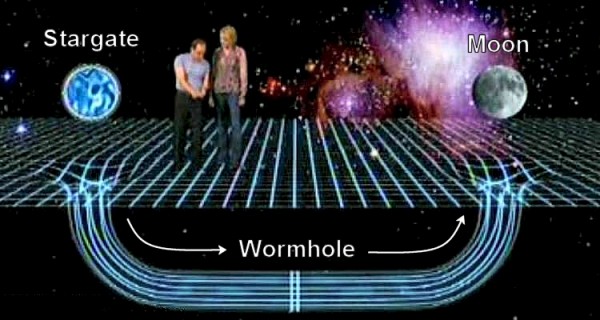
How so? You see, when you get enough mass (or other form of energy) in a small enough space, it becomes harder and harder to escape from it, gravitationally. The Earth isn't so bad; you "only" have to travel at about 25,000 miles-per-hour (~40,000 km/hr) to escape from its gravity, something we've been doing since the 1960s.

But if you keep turning up the mass, you'd need to travel faster and faster to escape. You can add mass to something arbitrarily, but as for velocity? There's a limit to that: the speed of light. If you make something so massive that you can't escape from it, even if you move at light-speed, congratulations! You've just made a black hole: something with gravity, but that emits no light; that anything can be sucked into, but that nothing can escape from!
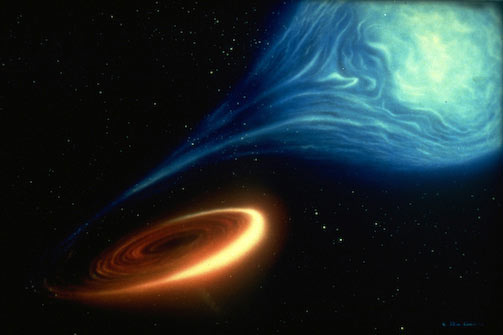
Well, the "reverse" of a black hole would be something that nothing can be sucked into but that everything can escape from: a white hole.
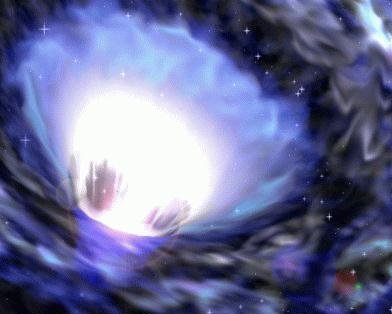
White holes are not observed to exist, but they are theoretically possible. Something interesting? If you have a black hole in one region of space, it could, in principle, be connected on the other end (in a separate region) to a white hole! The connection between the two -- the black hole and the white hole -- is known as an Einstein-Rosen Bridge, or more popularly, a wormhole.
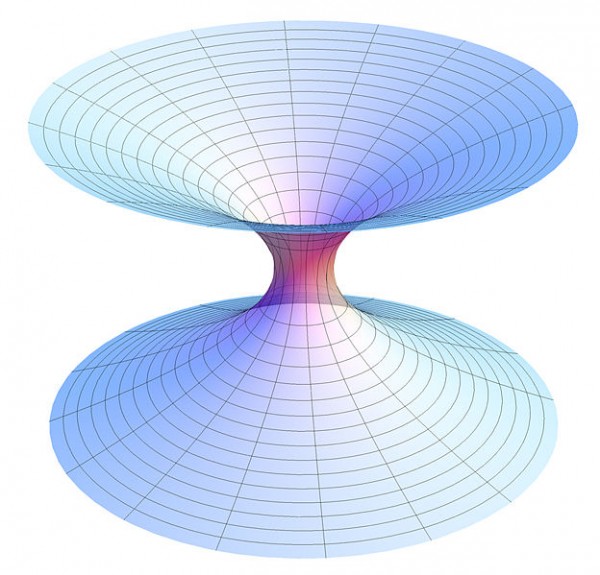
Some have speculated for a long time that when matter falls into a black hole, it emerges somewhere else as a white hole, and that this apparent "boom" of matter, seeming to come from nowhere, would look an awful lot like our Big Bang. In fact, some say, perhaps that's where our Universe got its start! It's an interesting idea that we have not been able to test (yet), but that is certainly a worthwhile speculation.
But recently, a paper has come out (and you can read the preprint here) that asks the question: could our Universe live in the "neck" of one of these wormholes?

Although this is making news on the net, I'm here to bring you back to reality. First off, this is not a new idea; it's been around since at least 1972. Second of all, what the author finds is that the interior of an Einstein-Rosen black hole is static, which is not a property of our (expanding) Universe.
But this paper does show a few interesting things. First off, this solution is stable, which means -- in principle -- that it can exist. Second off, it is possible that this can be generalized to make the space inside of it do other things besides remain completely static (like expand or contract). And third off, it brings up this amazingly interesting possibility that not only might our Universe be the inside of a black hole, but that each black hole that's come to exist in our Universe may house its own miniature Universe inside of it!
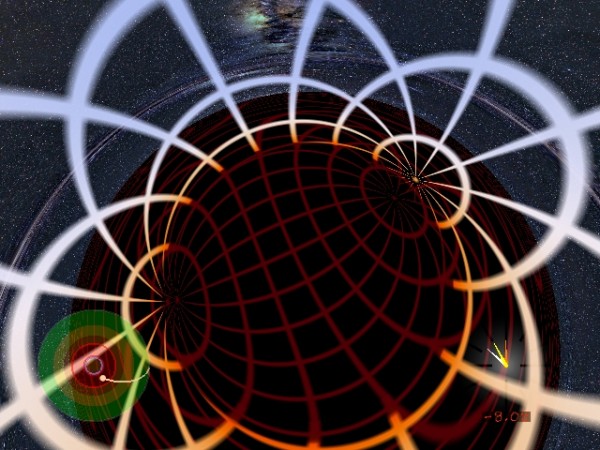
Is there any way to test this? Not yet, since a black hole like this would look identical from the outside to a plain old "I'm-a-singularity-at-the-center-and-nobody's-going-nowhere" Schwarzschild black hole.
So in summary, I'm skeptical that this idea is right, and I'm even more skeptical that this idea is testable in principle. But that doesn't mean it isn't incredibly interesting in its own right, and that further research might bear out some awfully interesting details. I have a feeling we'll be hearing about this one again sometime soon.

I have a feeling we'll be hearing about this one again sometime soon.
Probably right around 4:20. :)
maybe the universe is like an ouroboros, the head devouring the tail. all blackholes connect to the bigbang being the output, since the end point of the bridge could be that huge whitehole at the "beginning" of the universe. is there a possibility that all matter in the future becomes 1 super universe mass black hole? since we don't know what is dark energy (or the dark flow), perhaps once all matter is consumed in blackholes, we wouldn't have dark energy anymore (can dark energy escape the gravitational well of a blackhole), would space itself be consumed and the universe start to shrink? I guess I just like the symmetry of a big crunch from which a new big bang might reoccur.
(is the event horizon of a universe mass blackhole the visible universe anyway)
How is the arrow of time treated with the white hole conclusion of the Einstein-Rosen Bridge?
Steve Novella had used this item on his "Science, Fact or Fiction?" segment of last week's Skeptics' Guide to the Universe". I was easily able to deduce that it had to be the "fact" because no one in their right mind (except for a theoretical astrophysicist) could up with something like this (and also because one of the other two options, a species of fish that survive without any oxygen at all was obviously the fiction).
I'm puzzled...if black holes swallow up even whole galaxies by the thousands, spit 'em out the inverse white hole to form new universes, and each new universe is infinite as we currently understand them, wouldn't each succeeding universe be, necessarily, populated by less and less matter, etc.? Having real trouble comprehending how that would work and its effect on quantum physics.
Help please!
Time flies like an arrow
Fruit flys like a banana
Sorry Wayne, the fish (actually some invertebrate) story is true: http://www.usnews.com/science/articles/2010/04/12/multicelled-animals-m…
The scary part, the universe as expanding along the tunnel of a worm whole is so much easier to grasp than inflation and dark energy.
One question so, in regards to Schwarzschild black holes and the universe, is the universe larger or smaller than it's Schwarzschild radius at the moment?
Ethan,
Longtime reader, first time commenter. I wonder if you want to comment on article I saw in Scientific American that theorizes that Black Holes are really Black Stars.
Link-Oct2009
Contrary to physicistsâ conventional wisdom, a quantum effect called vacuum polarization may grow large enough to stop a hole forming and create a âblack starâ instead.
I have read the paper "Radial motion into an Einstein-Rosen bridge" by Nikodem Poplawski.
As far as I can see, the abstract says "... our own Universe may be the interior of a black hole existing inside another universe", but the paper itself does not contain such a statement, and the theory presented by Poplawski wouldn't justify it.
That "our own Universe" is "the interior of a black hole existing inside another universe" is a precondition, used by Poplawski, which *would* us as observers enable to make measurements in order to see, whether particles entering the black hole move as Poplawski's theory predicts. Otherwise, this would not be possible -- as Poplawski admits --, and the theory would not be falsifiable, which, as you may know, is ... er ... unfavorable.
Looking at the layout of the whole thing, it could very well be, that the Elsevier editor S. Dodelson invented the statement quoted. Who knows.
Here we have (a) a theory based on a totally unsupported precondition, and (b) scientifically useless media hype.
@Mu:
Well, we still don't even know if the universe is finitely or infinitely large, so it is not possible to answer this question... (or did you only mean the observable part of the universe?)
I wanted to point out that an Einstein-Rosen bridge is not a connection between a white hole and a black hole: the Einstein-Rosen bridge does not distinguish between which side of the wormhole 'mouth' you are. Since you a black hole is something you can 'never escape from' and a white hole is something you can never be sucked into, you're in fact talking about a one-way connection which does not reflect the Einstein-Rosen bridge solution.
Furthermore, the Einstein-Rosen bridge still has a singularity at the center (it's still a Schwarzschild Black Hole, but dressed up with a coordinate transformation), so not only would it look identical but it in fact is identical to a '"I'm-a-singularity-at-the-center-and-nobody's-going-nowhere" Schwarzschild black hole' (also making an Einstein-Rosen bridge unfit for travel since the tidal forces experienced near the singularity would obliterate any living thing).
Do we live inside of a wormholes neck? Good question and a nice simple explanation.
My answer is not "No", but it is also not "Yes" and also not 'maybe"; it is a specific something else. Because I think Ethan has thought about some concepts and made assumptions about others in ways that are conceptually different than how I think about fundamental physics hypotheses.
First, let me agree that there are many black holes in our visible universe and that I agree with theory, right up to the event horizon (i.e. right up to testability).
#1, let me assert that the "event horizon of our visible universe" (beyond which no telescope can see) is the event horizon of a white hole. (I use the term "white phenomenon" with a slightly different definition; but not to quibble here.)
Now Ethan's confusion. Notice that our visible universe is between the "black-hole-event-horizons of our visible universe" and the "white-hole-event-horizon of the big bang". But this does not mean that our universe is like being between the two ends of a long multi-Y pipe; where the black holes are the multi end of a multi-Y pipe and the big bang is at the single end of a multi-Y pipe. If a pipe has an inside and an outside; and if similarly a wormhole has an inside and an outside; then our visible universe is not "inside a wormhole" or "inside a wormhole's neck"; it is "outside of a wormhole-ish something". And being "outside of a wormhole-ish thing" is not necessarily the same idea as "not inside a wormhole". Which means what?
Let's clarify a bit. Ethan's description implies some kind of a cosmic cycle (though I'd be happy with a galactic cycle). So if I take the white-hole-event-horizon of the big bang and the black-hole-event-horizons at the center of galaxies in the entire visible universe; my question is what am I missing in that "wormhole" cosmic cycle? or even a plain vanilla "big bang" cosmic cycle?
My simple answer is:
1) antimatter. The missing antimatter has not been satisfactorily solved. Where does it reside in a credible cosmic cycle. I prefer the phrase "cosmic cycle" to the word "cosmology".
2) time is incorrectly defined. time is neither from 0 to oo or from -oo to +oo. Elsewhere I've described that time is a Moebius dimension (Yes, my unvetted hypothesis).
3) Everyone assumes that the "event horizon of the big bang" is a quantum phenomenon. (i.e. that a white-hole-event-horizon is a quantum phenomenon. Meanwhile, everyone assumes that a black-hole-event-horizon can be a classical phenomenon, (i.e. that an astronaut could drift into a black hole unawares.)) I don't think so; I assert that quantum physics begins right at the event horizon whether micro or macroscopic. (there are many macroscopic quantum objects, e.g. a liter of liquid helium). I suggest that the mathematics of general relativity breaks down not at the Plank dimension but at an event-horizon of any dimension. I know of no data either way for inside a black-hole-event-horizon. But I assert that black-hole-event-horizons are 100% quantum phenomenon just like single slits. What does this mean?
If an elephant goes through a single slit as a classical object; the single slit will be smashed to pieces; but if an elephant goes through a single slit as a very large number of quantum particles; the entire elephant (ensemble of quantum particles) will be disaggregated in going across the single slit and smeared across space as a distribution spectrum of elementary particles on the other side of the slit. Physics talks of an elephant or a baseball having a finite probability of quantum mechanically going right through a wall, I think of as nonsense.
Now if I define time as a Moebius dimension, nothing changes in our visible universe. But the Ethan's black-hole/white-hole picture no longer looks like a simple pipe; it begins to look more like a Klein bottle. But to fix the problem that we are neither inside of a simple pipe wormhole nor outside of a simple pipe worm hole; we need to fix the antimatter problem. I need (sort of) two interconnected Klein bottles (which means extra dimensions for an antimatter subuniverse). And Yes that subuniverse is curled up relative to ours and ours curled up relative to theirs and neither subuniverse can tell whether they are in an antimatter or a matter subuniverse. Matter is the convension for the stuff we are made of and the other is antimatter. We can't tell fundamentally right from left, north from south or if we are in antimatter or a matter visible universe. (I can find the Hawking quote if needed).
----
One more little thought here:
1) From one inertial frame I am at rest.
2) From another inertial frame I am travelling at any velocity up to speed of light.
3)Thus an observer who sees me in condition 2) seems my image as significantly redshifted than an observer who sees me in condition 1). As well in condition 2) my apparrent mass can become so great that eventually I become a black hole (i.e. there is no visible image of me, I am somehow inside an event horizon, or should I say "apparent event horizon"). Yes I know I am probably being inconsistent with what I've said before but I'm just thinking.
Now my quesiton is this: is there in theory a mathematical (algebraic, equation) kind of way of describing an expanding universe as a non-expanding universe; because I think topologically a static universe, an expanding universe or a shrinking universe are indistinquishable? Thus in principle there ought to be a set of algebraic expression equivalent to the topological idea. That's a fuzzball question; but any thoughts any work in this area will be appreciated.
So yes I like Ethan's blog question very much. And I encourage further work.
Yes, yes my ideas are unvetted hypotheses.
if our universe is the inside of a black hole, then the universe will end. it's Hawking radiation will take away energy so eventually, there will be nothing left.
Bjoern, I don't know if I'm completely lost, but to me, if we assume some form of function describing the expansion of universe for the last 14 billion years we should come up with some number which puts a maximum diameter on the universe ( I think 46 billion ly was discussed here at some point). We also seem to have some number of how much mass is in that universe, which should allow us to calculate a Schwarzschild radius.
Really, I'm not trying to come off smart but this concept came to me when I was 16. I wondered if we were inside of a black hole, since all the matter inside could be shot out into an expanding bubble in "space" rather than compacted into a singularity. I also wondered if every black hole in our universe was just another created universe. I guess the difference is that this person knows the math and physics :)
@Mu: The number of 46 billion lightyears is, as far as I know, the diameter of the *observable* universe - not that of the whole universe.
If the universe has a closed geometry, then yes (although this depends on how good out measurements of Omega, the ratio of the actual density to the critical density, are). But if the universe is flat or open (and does not have a complicated shape like a donut), then it is infinitely large, and has always been.
Wouldn't a white hole just create a TON of black holes? If something with any mass is accelerated away from one at the speed of light (near), does the particle not become infinitely massive, creating a black hole?
the expansion of universe for the last 14 billion years we should come up with some number which puts a maximum diameter on the universe ( I think 46 billion ly was discussed here at some point). We also seem to have some number of how much mass
the expansion of universe for the last 14 billion years we should come up with some number which puts a maximum diameter on the universe ( I think 46 billion ly was discussed here at some point). We also seem to have some number of how much mass
Hi, I am 13 years old and I am fascinated with this theory. So what has occured to me so far, is that you have one singularity, and this singularity has another side, and on the other side there is a white hole. This concept is called a wormhole. The white hole expells all energy, even light, which means theoretically you can travel into a black hole(Providing you have a supply of relevant dark matter to sustain the black hole) and come out the other side from a white hole.
Please tell me if I am analyzing this theory correctly.
Thanks, Gnome
hjofsafshiomknegshiootegesdhiuhgeeeoidggdfg
I LIKE CHICKEN WHEN IT IS COOKED IN A WORMHOLE!!!!!!!!!!!!!!!!!!!!!!@#$%^&*()&#%&
if something goes into black hole and comes out from white hole and boom! means i want to say that the thing which goes into black hole and and comes out of white hole is like coming out of matter world and destroys in anti-matter world so may be black hole is combined with matter world and antimatter world
Recently i had a big idea in relation with the inner (hollow) earth 'mythology': what if the pole zones are the entrances in a wormhole which contains that 'inner earth' world.The passing through that entrances could be smooth so as a navigator(see admiral Byrd or Olaf Jansen or others)cannot realize he is in the 'neck' of the wormhole; inside, the gravity conditions can be provided due to the negative curvature of the hipertorrus which basically describes the shape of the neck; the substance is distributed in accordance with the equipotential surfaces of the gravitation field.
I analised the 2+1 dimensions situation and it seems to be valid; why not extend its validity at 3+1 (the case of our space-time continuum); the only difficulty is that of the numerical values for the masses and forces that the scientists considered to be enormes to maintain such a big wormhole; maybe can be obtained others solutions of the Einstein's field equations to be in accordance with the dimensions and the mass of the earth. Just think of it...
In future if a man travel more than the speed of light he may jump (ex:2010 to 2100).But how it is possible to come back his own time.
SCIENTISTS MAKE THE TIME MACHINE AS SOON AS POSSIBLE.SO WE CAN TRAVEL IN PASTT PRESENT AND FUTURE.. I WILL MAKE THE PROBLEM SOLVED OF WORLD. EVERYBODY CAN SAVE THE LIFE FROM ACCIDENTS AND SAVE THE LIFE.. I WANT TO KNOW IS RESEARCH IS GOING ON TIME MACHINE. PROVE IT SCIENTIST THAT YOU CAN MAKE THE TIME TRAVEL POSSIBLE...
THIS EARTH IS A SHIT AND NOTHING ELSE.. HUMAN BEING IS PLAYING WITH NATURE. KILLING OTHER HUMAN BEINGS. THEY ARE INSANE AND ANIMALS ARE DYING. I AM DESTROYING THIS EARTH ON 21-12-2012 NIBRU BLACKHOLE VOLCANO TSUNAMI STROMS HURRICANE IS COMING ON EARTH SOON..
YOU WILL DIE SOON HUMANBEINGS..
YOUR,
JESUS
INRI
the expansion of universe for the last 14 billion years we should come up with some number which puts a maximum diameter on the universe ( I think 46 billion ly was discussed here at some point). We also seem to have some number of how much mass
Hi, I am 13 years old and I am fascinated with this theory. So what has occured to me so far, is that you have one singularity, and this singularity has another side, and on the other side there is a white hole. This concept is called a wormhole. The white hole expells all energy, even light, which means theoretically you can travel into a black hole(Providing you have a supply of relevant dark matter to sustain the black hole) and come out the other side from a white hole.
Please tell me if I am analyzing this theory correctly.
Thanks, Gnome
gfdt43eyrhyjnyutrsttyfsdsdretytygvfxsssrtr445 treeareaytrhgfb6q4
the expansion of universe for the last 14 billion years we should come up with some number which puts a maximum diameter on the universe ( I think 46 billion ly was discussed here at some point). We also seem to have some number of how much mass
Hi, I am 13 years old and I am fascinated with this theory. So what has occured to me so far, is that you have one singularity, and this singularity has another side, and on the other side there is a white hole. This concept is called a wormhole. The white hole expells all energy, even light, which means theoretically you can travel into a black hole(Providing you have a supply of relevant dark matter to sustain the black hole) and come out the other side from a white hole.
Please tell me if I am analyzing this theory correctly.
Thanks, Gnome
the expansion of universe for the last 14 billion years we should come up with some number which puts a maximum diameter on the universe ( I think 46 billion ly was discussed here at some point). We also seem to have some number of how much mass
Hi, I am 13 years old and I am fascinated with this theory. So what has occured to me so far, is that you have one singularity, and this singularity has another side, and on the other side there is a white hole. This concept is called a wormhole. The white hole expells all energy, even light, which means theoretically you can travel into a black hole(Providing you have a supply of relevant dark matter to sustain the black hole) and come out the other side from a white hole.
Please tell me if I am analyzing this theory correctly.
Thanks, Gnome
1) From one inertial frame I am at rest.
2) From another inertial frame I am travelling at any velocity up to speed of light.
3)Thus an observer who sees me in condition 2) seems my image as significantly redshifted than an observer who sees me in condition 1). As well in condition 2) my apparrent mass can become so great that eventually I become a black hole (i.e. there is no visible image of me, I am somehow inside an event horizon, or should I say “apparent event horizon”). Yes I know I am probably being inconsistent with what I’ve said before but I’m just thinking.
Now my quesiton is this: is there in theory a mathematical (algebraic, equation) kind of way of describing an expanding universe as a non-expanding universe; because I think topologically a static universe, an expanding universe or a shrinking universe are indistinquishable? Thus in principle there ought to be a set of algebraic expression equivalent to the topological idea. That’s a fuzzball question; but any thoughts any work in this area will be appreciated.
So yes I like Ethan’s blog question very much. And I encourage further work.
" As well in condition 2) my apparrent mass can become so great that eventually I become a black hole"
No, it can't. I'm afraid you're going to have to go into the maths used, not handy-wavey it. You're using the english layman short version of the theory to make up a strawman idiocy of the actual theory.
This is not valid.
Black holes, dark energy, anti-matter,fabric of time and worm holes are not easy to digest for a layman like me. still i would like to hear about them and understand what little i could.
What if the white holes were not just a white hole but the sun and stars and photons too and matter as well